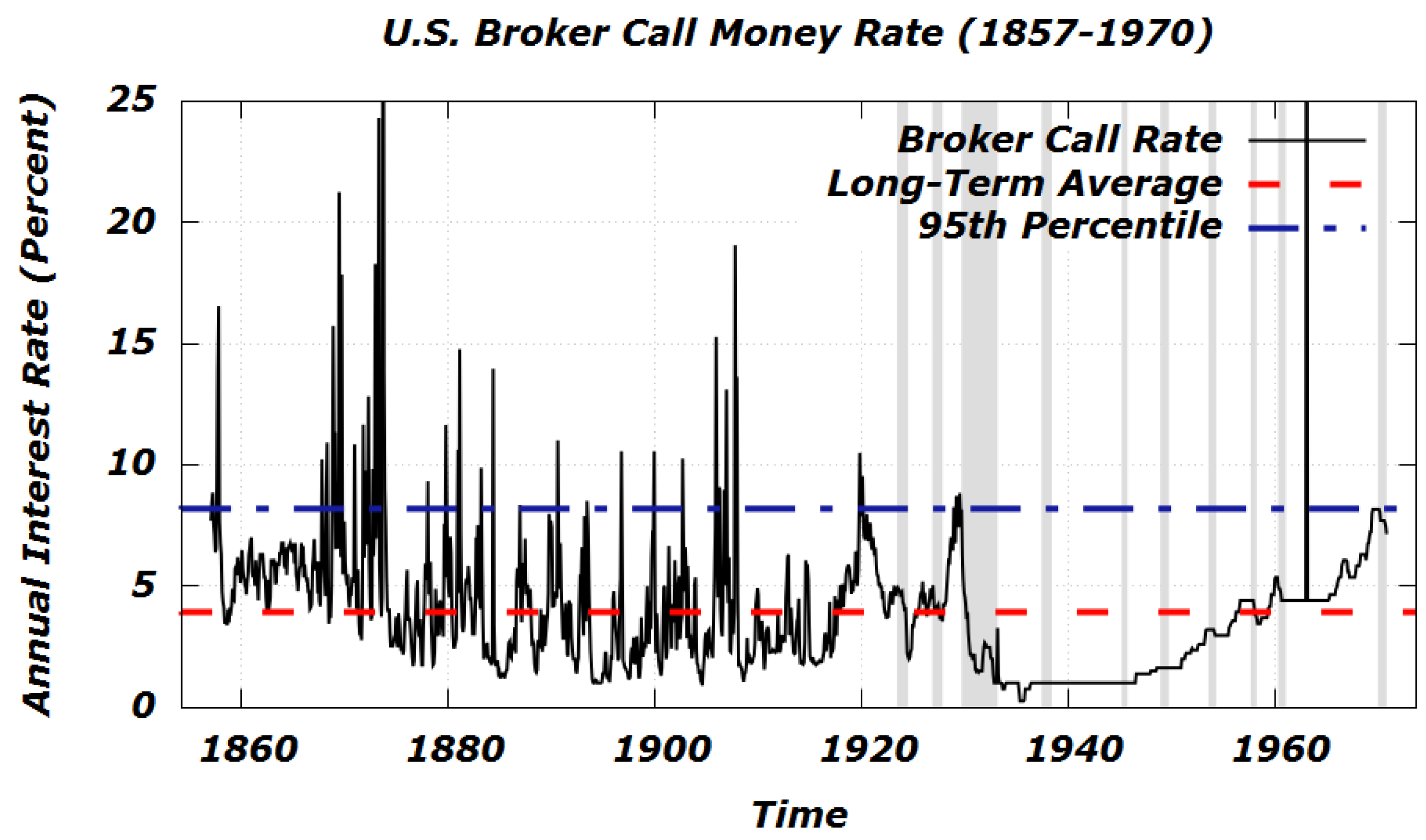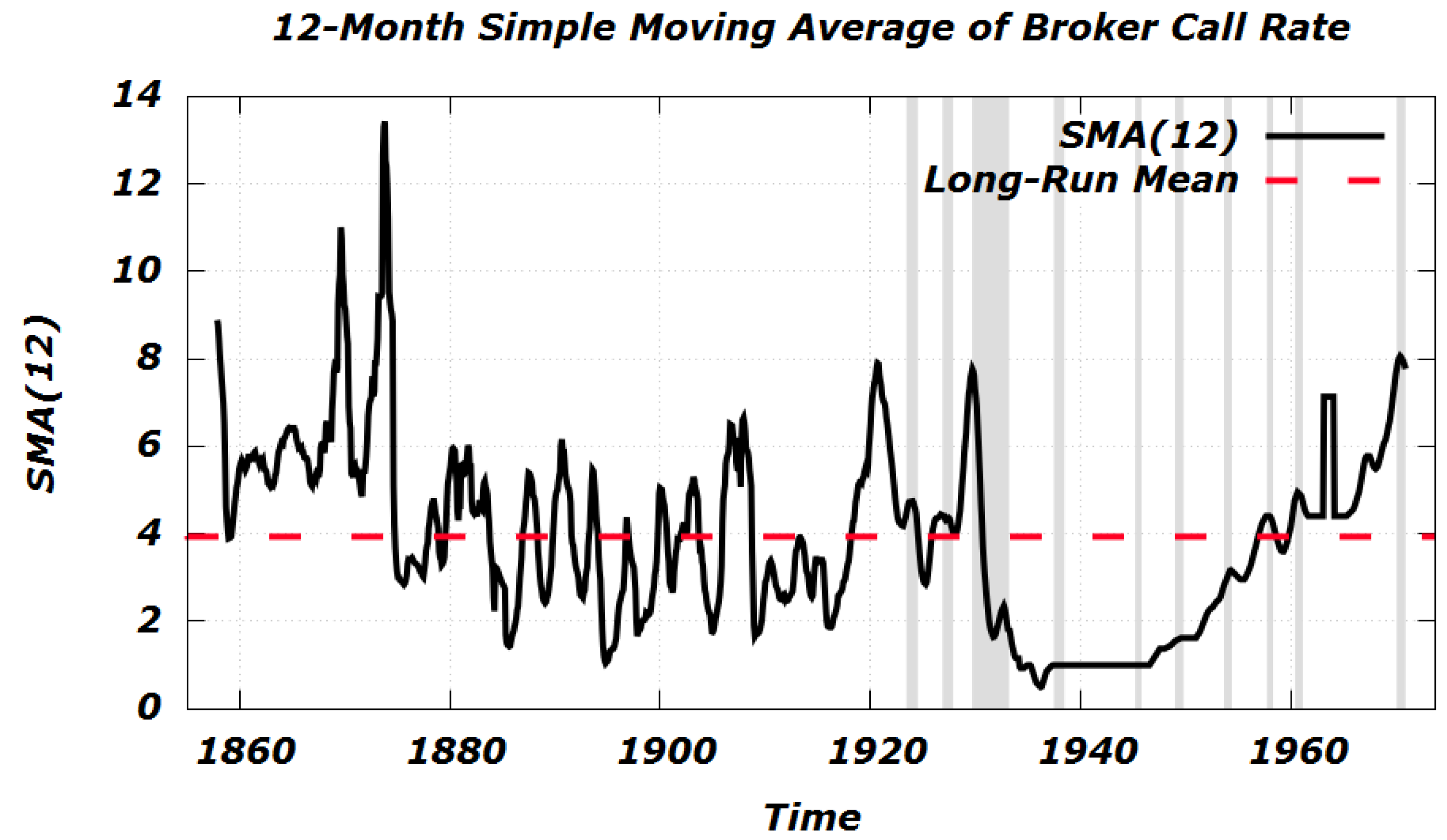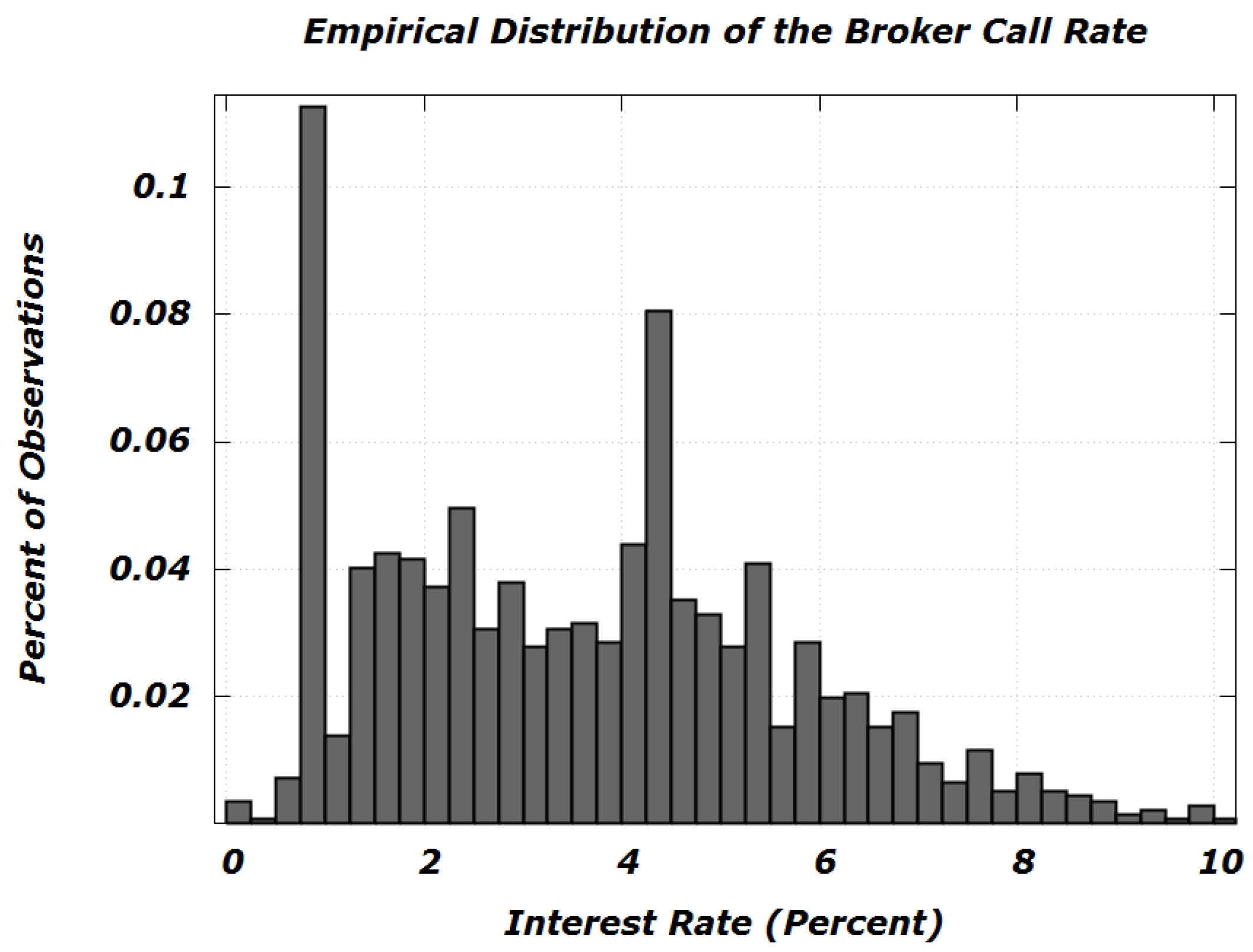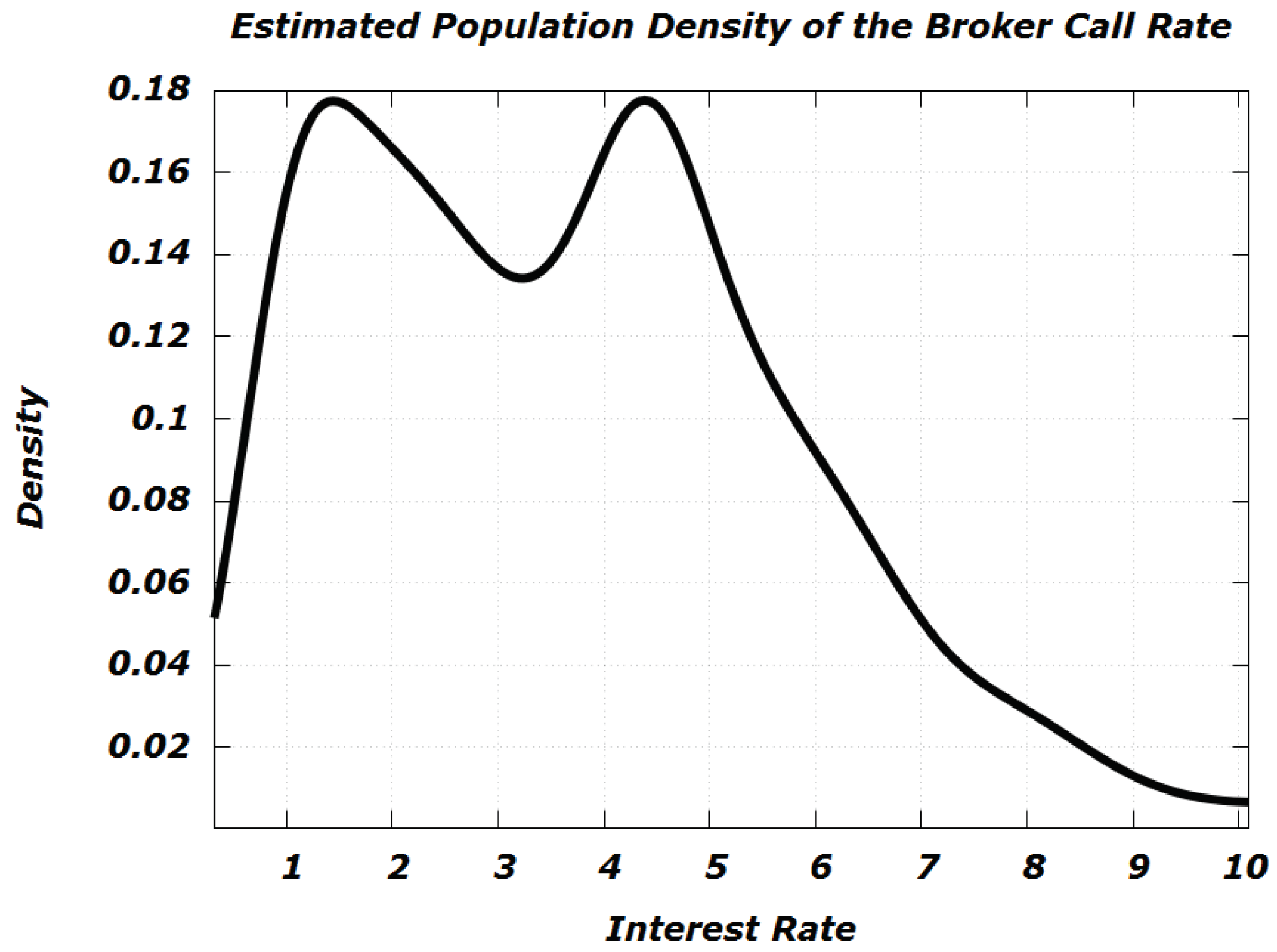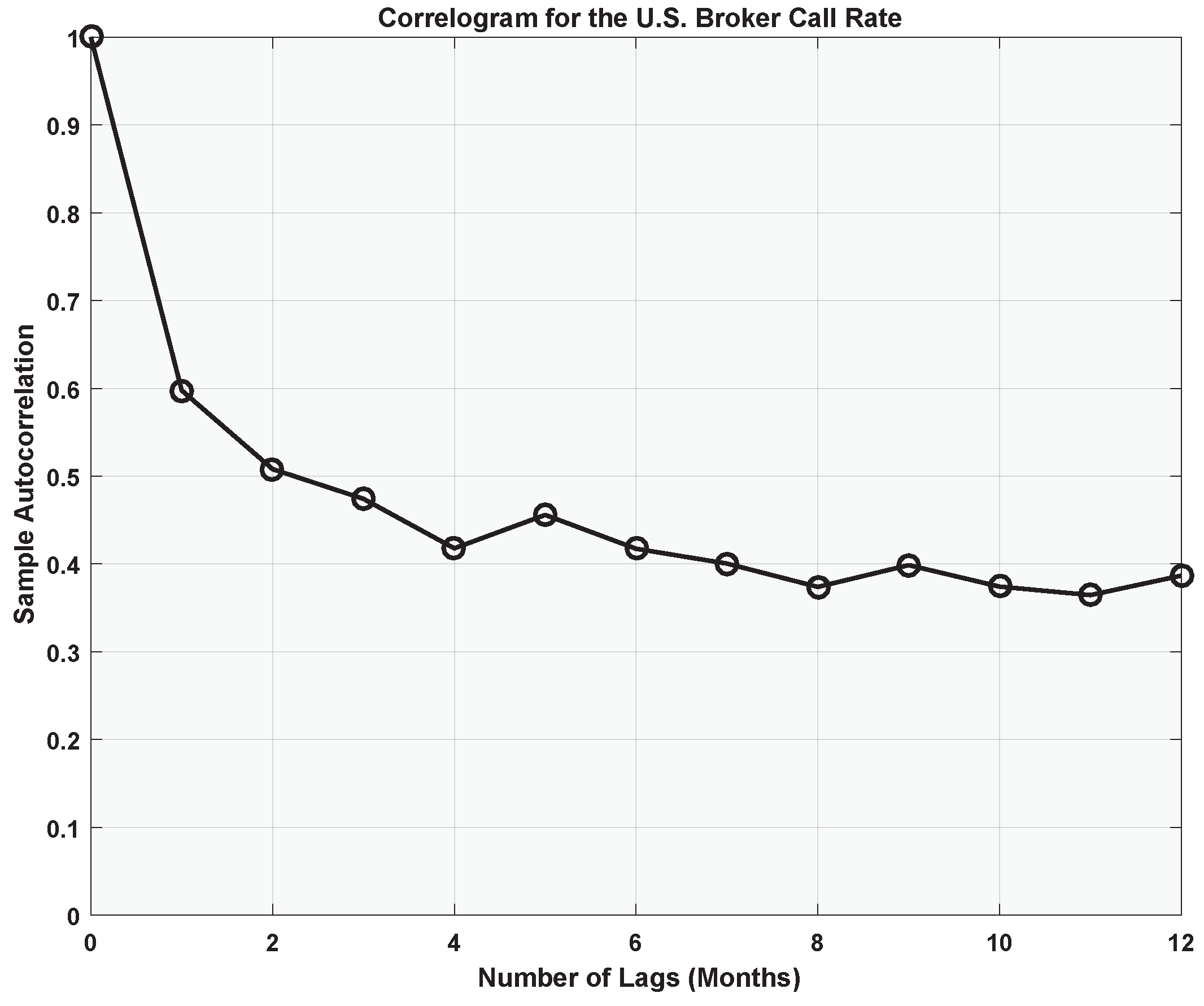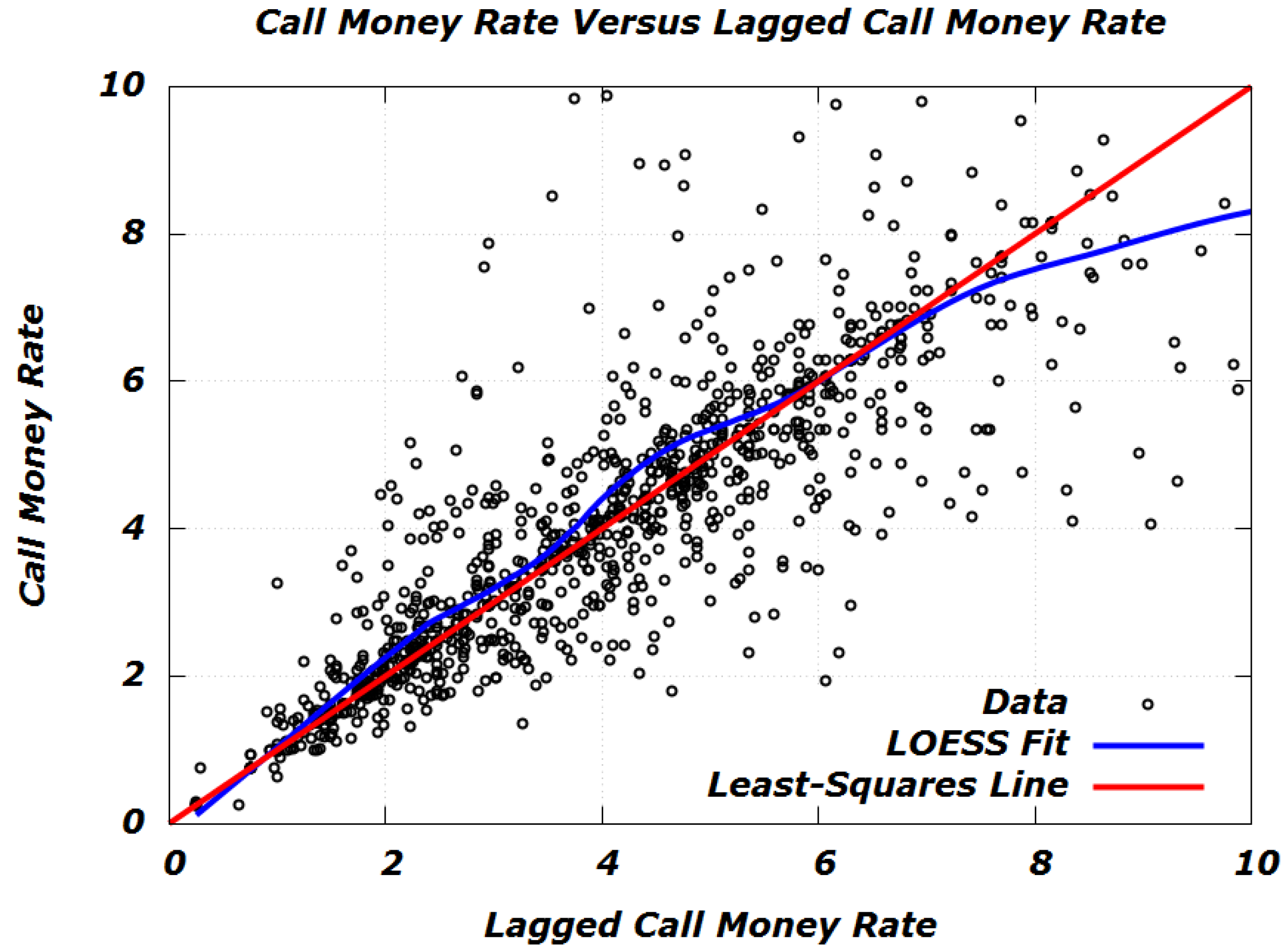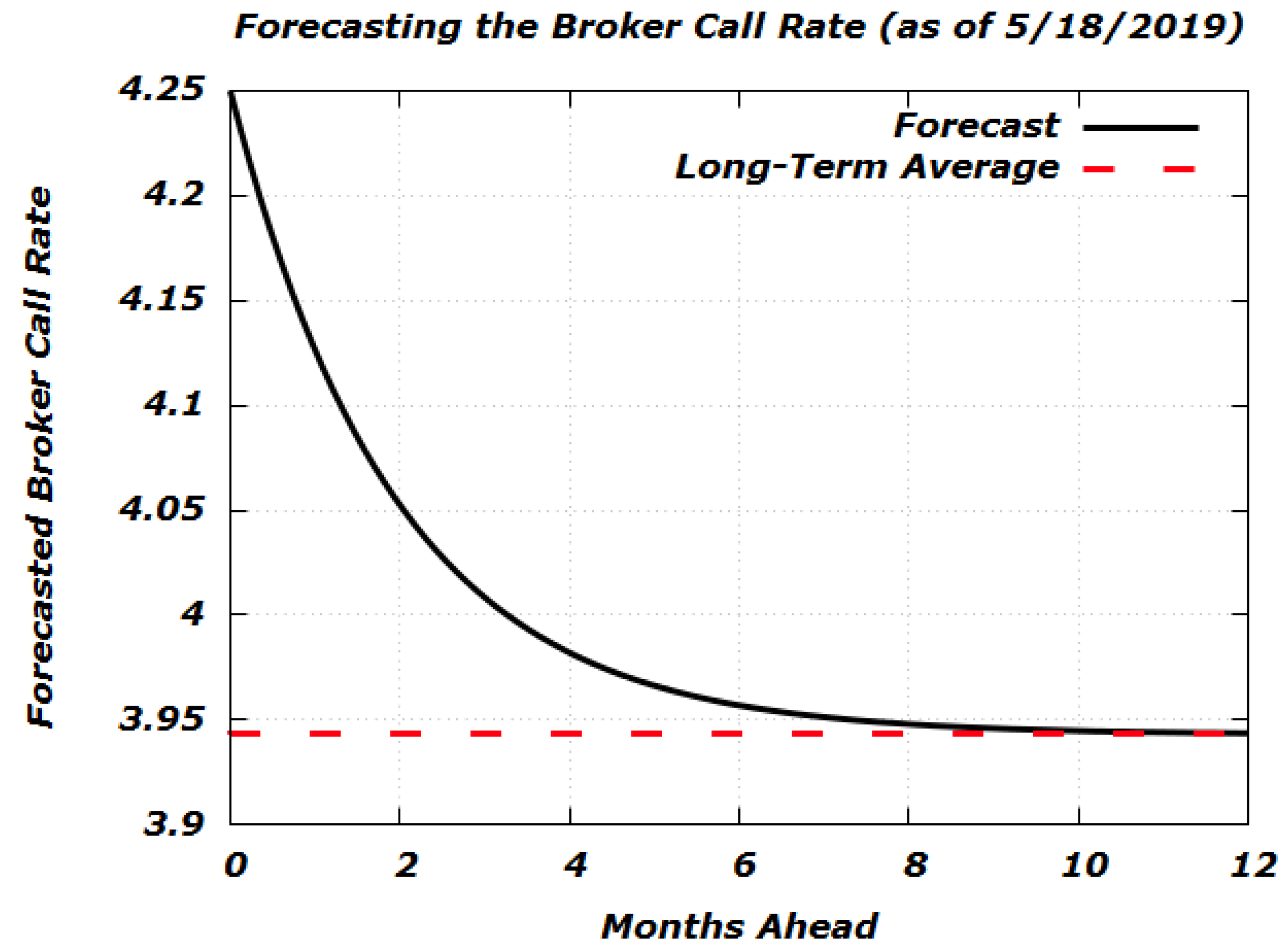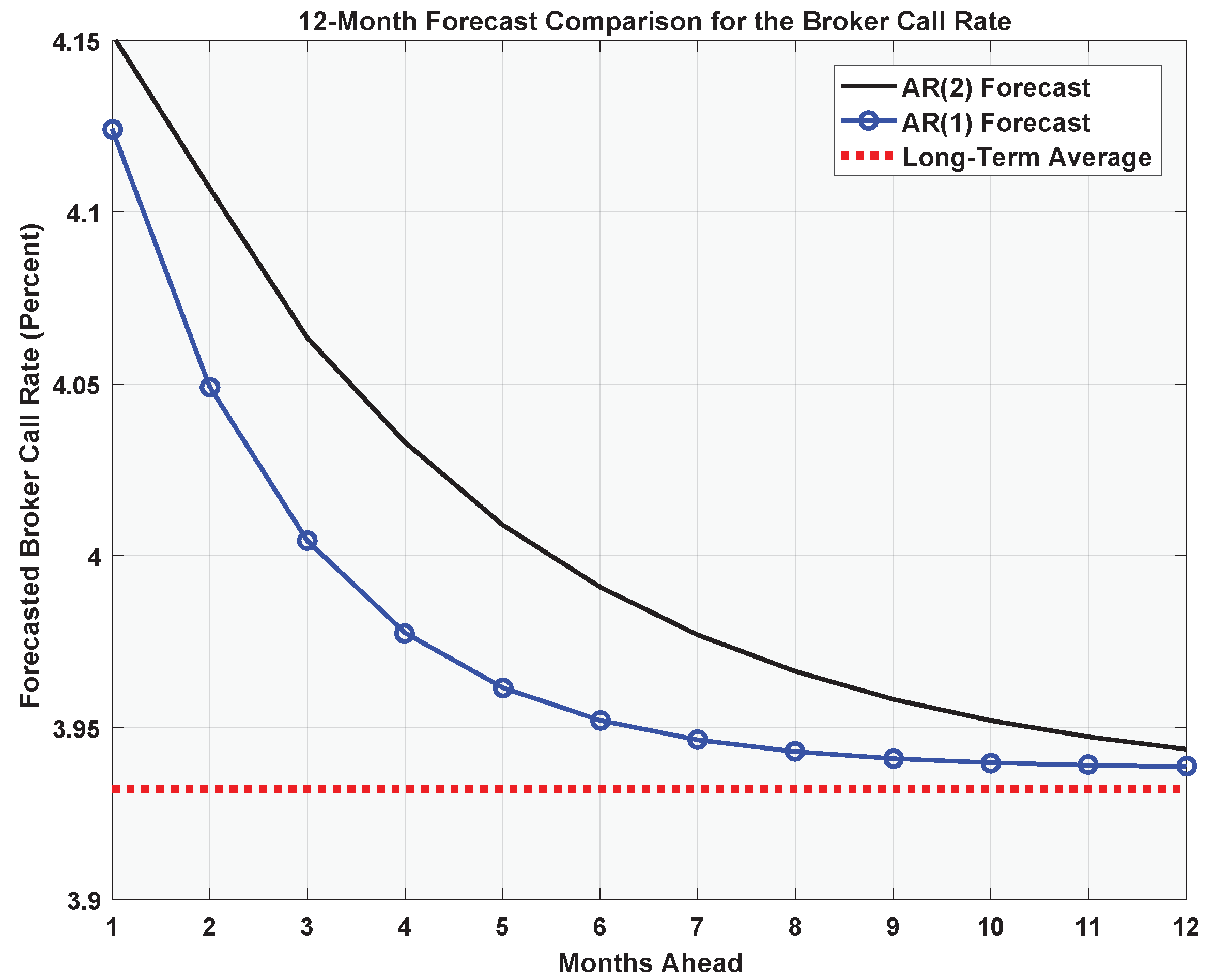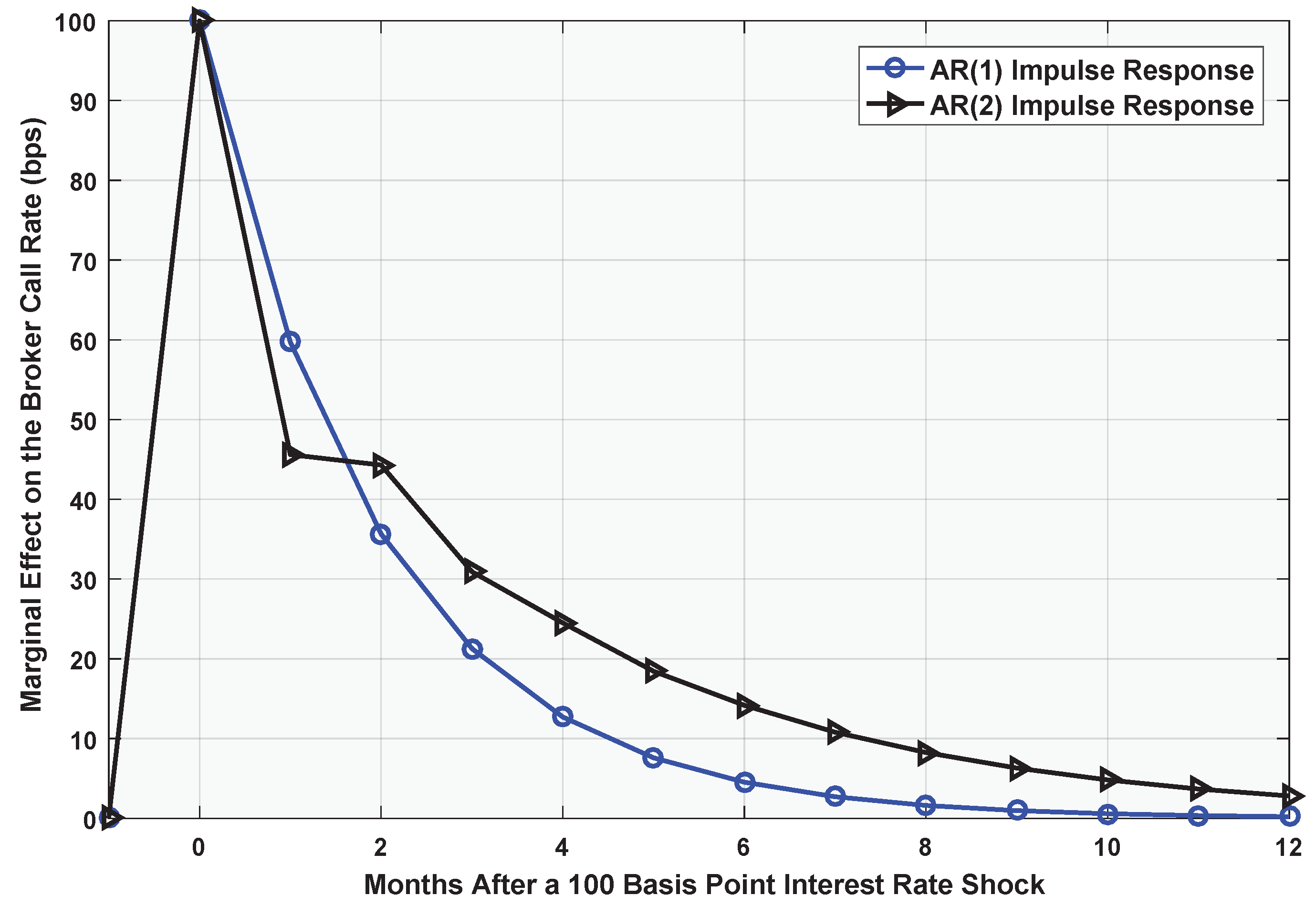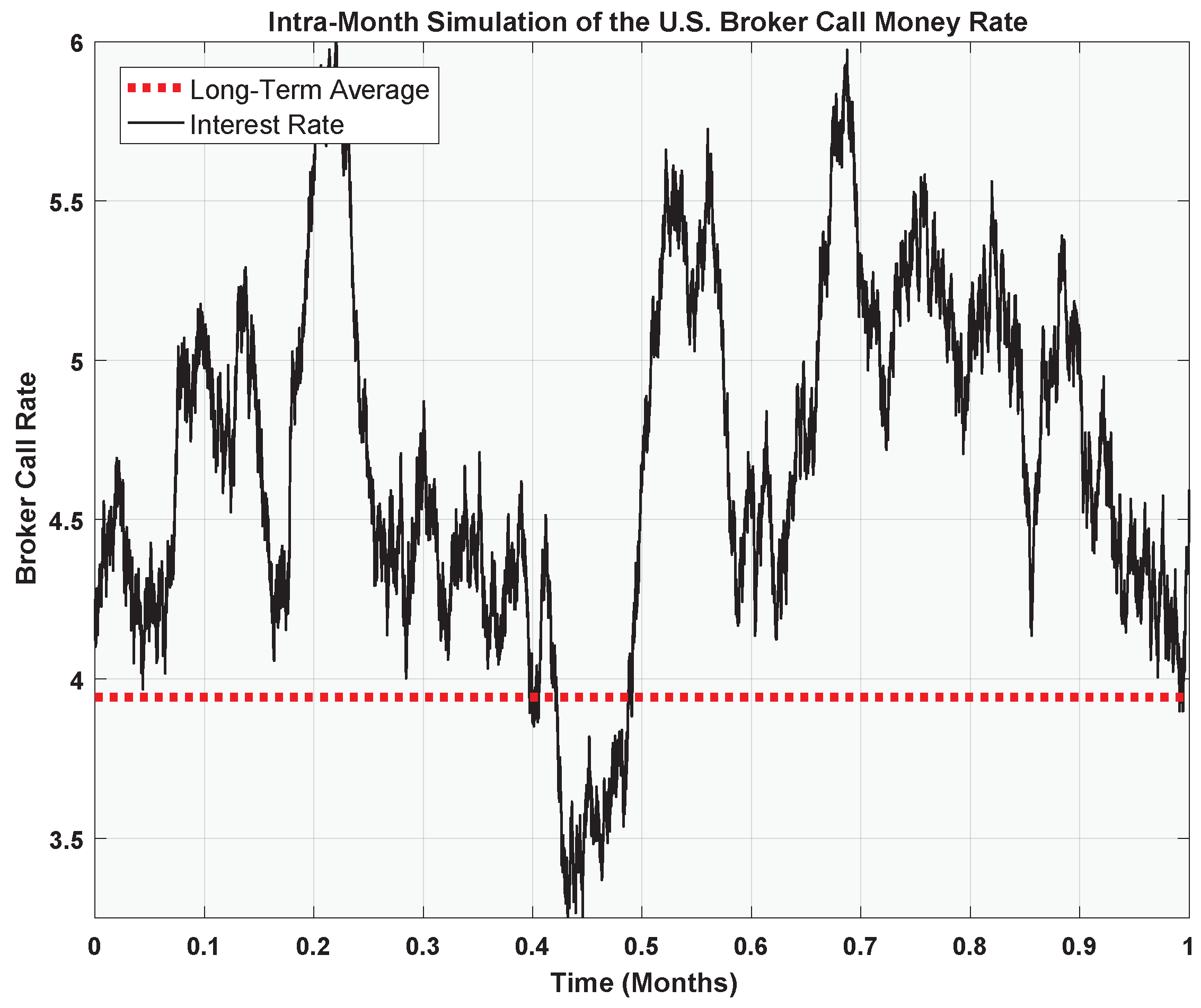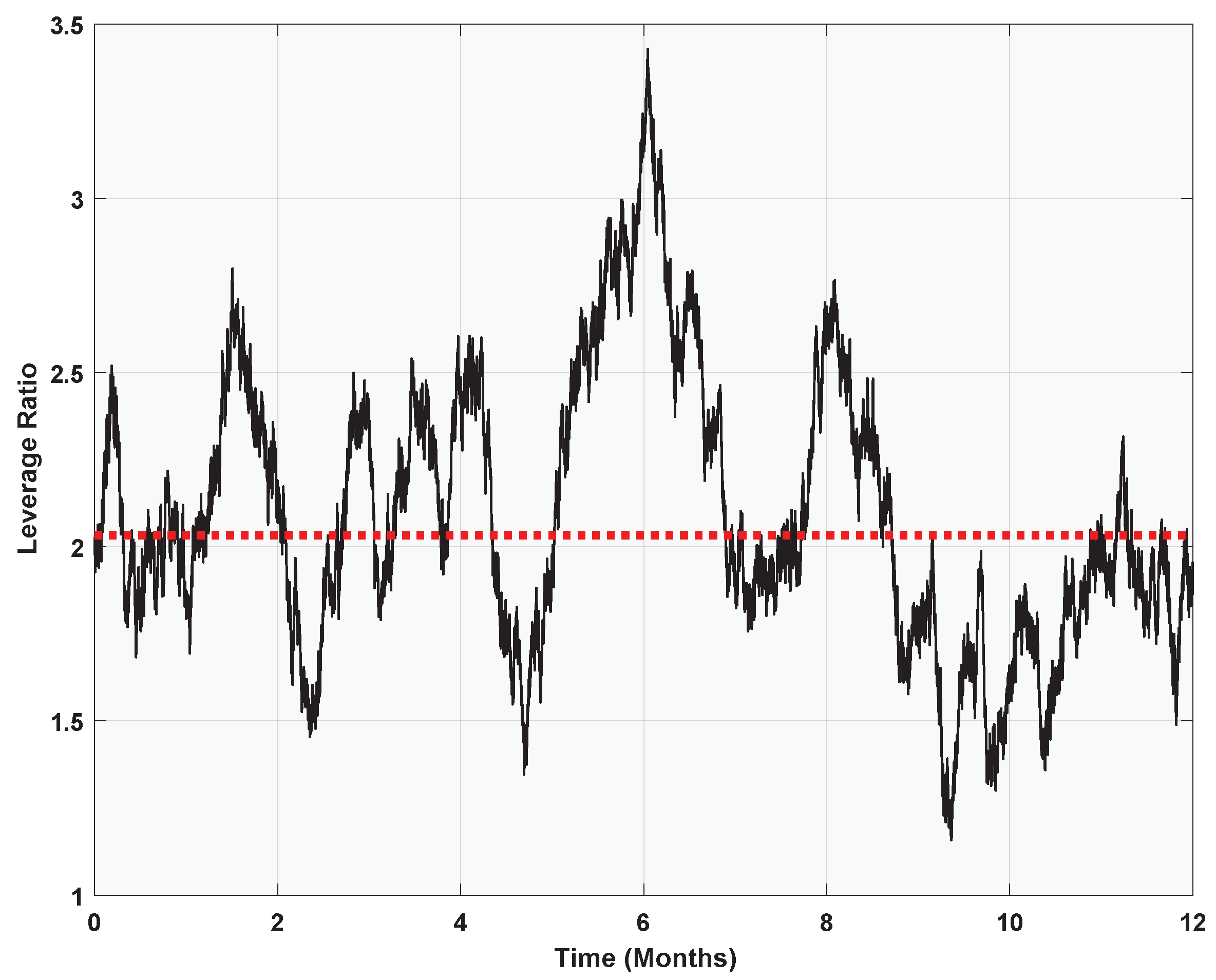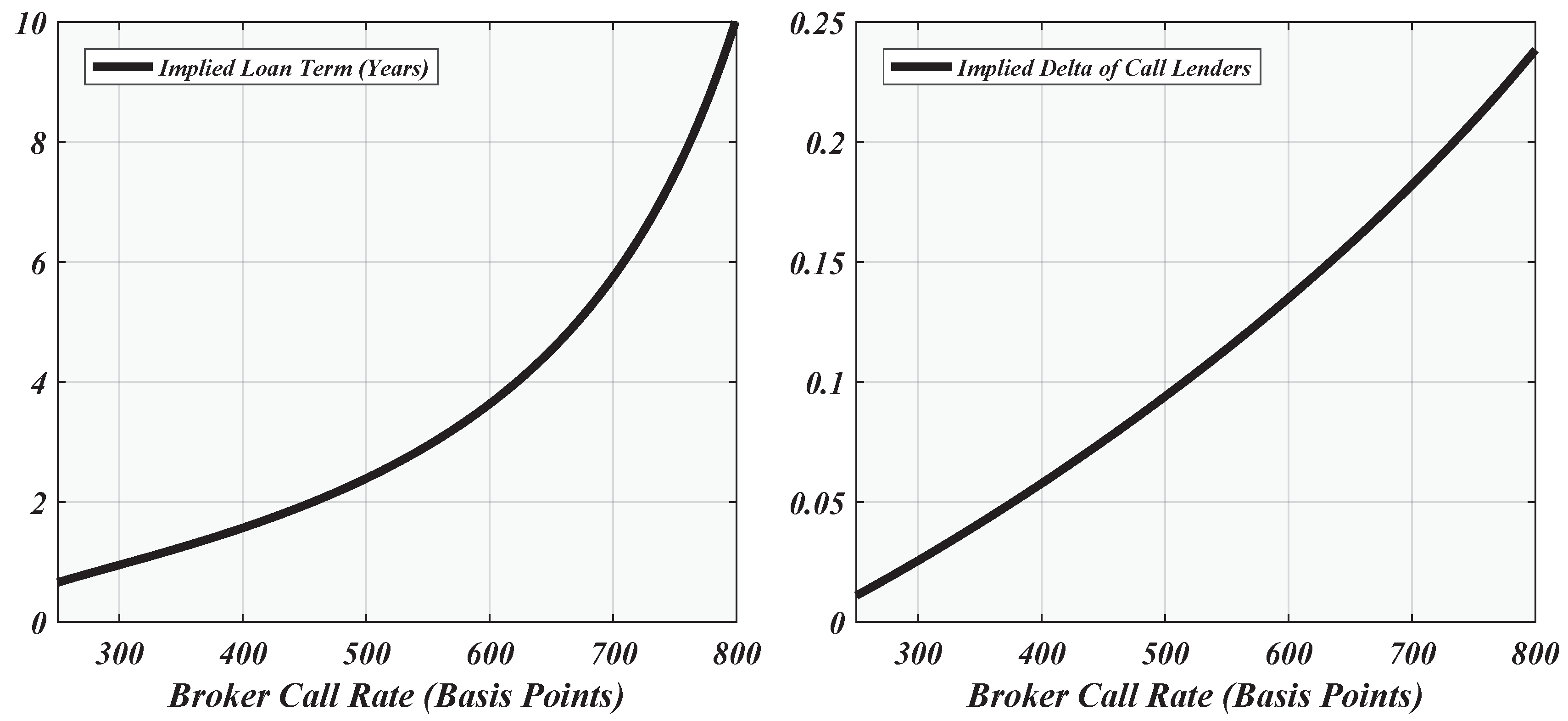1. Introduction
This paper adds to the literature on margin loan behavior in the stock markets of developed economies by estimating some mean-reverting stochastic processes for the U.S. broker call money rate in both discrete and continuous time. The broker call rate is the interest rate that banks and other financial institutions charge for short term credits to investment brokerages, who in turn loan the money to their clients (at a markup) in the form of margin debt.
We combine these purely empirical specifications with the author’s prior theoretical formulas on margin loan pricing (cf. with
Garivaltis 2019a,
2019b) in order to derive empirical stochastic processes that govern the time series for brokers’ margin loan interest rates and the (unobservable) leverage ratios of their most well-heeled and sophisticated clients (e.g., continuous-time Kelly gamblers). Thus, the present work enhances the literature by offering hybrid empirical/theoretical statistical models of certain financial time series (e.g., the margin loan interest rates charged by brokers to their retail clients) for which the existing set of historical data is either nonexistent or very spotty, at best.
To be more specific, our particular contribution amounts to combining the empirical time series for the U.S. broker call rate with the following two theoretical relationships derived by the author in his prior work (e.g., in the first two installments of his Margin Loan Trilogy ).
- ■
The instantaneous monopoly price of margin loans to
Kelly (
1956) gamblers:
- ■
The negotiated interest rate under instantaneous
Nash (
1950) Bargaining
1 with Kelly gamblers:
In these formulas,
denotes the (continuously-compounded) margin loan interest rate charged by the broker over the differential time step
, where
is the asymptotic (or logarithmic) growth rate of the stock market index,
is the annual volatility, and
is the annual (arithmetic) drift rate.
denotes the broker’s cost of funding (“broker call money rate”) for the duration
. These formulas are of great interest on account of their simplicity and their practicality; naturally, the broker charges more if the underlying growth opportunity
is more favorable (higher
, lower
). Because all the action (the broker posts a monopoly price, or the principals Nash bargain over both the price and quantity of margin loans) happens over the differential time step
, the formulas apply equally well to a general situation whereby the stock market index
is governed by time- and state-dependent parameters
and
. The affine relationships (
1) and (
2) imply that the net interest margin
must shrink whenever the broker call rate
increases;
ceteris paribus, for a 100 basis point fluctuation in the broker call rate, only 50 bps will pass through to the consumer (or 75 bps under Nash Bargaining).
The purpose of this article, then, is to use empirical data to divine the general laws of motion of the U.S. broker call rate , and to study the logical consequences for the random behavior of margin loan interest rates, risk premia, and the leverage ratios of continuous time Kelly gamblers. The U.S. broker call money rate, which is published daily in periodicals like The Wall Street Journal and Investor’s Business Daily, is so-named because stock brokers must be prepared to repay these funds immediately upon “call” from the lending institution.
The paper is organized as follows.
Section 2 describes our data set, which consists of some 1367 monthly observations (covering the years 1857–1970) published by the Federal Reserve Bank of St. Louis (FRED). We estimate the mean-reverting (monthly) specification
and use it to construct a classical method-of-moments estimator of the analogous Ornstein–Uhlenbeck process (or Vasicek model) in continuous time. Inspired by the fact that Bankrate.com reports only the two most recent monthly observations of the broker call rate, we develop some out-of-sample forecasts based on the empirical AR(2) model
Section 3 juxtaposes the empirical specifications (
5) and (
6) with the theoretical pricing formula (
1) to derive stochastic differential and difference equations that must govern the evolution of the margin loan interest rates charged by stock brokers. As an application, we deduce and simulate the implied law of motion for the leverage ratios of continuous time Kelly gamblers. Finally,
Section 4 applies
Merton’s (
1974) arbitrage theory of corporate liability pricing to derive theoretical constraints on the risk premia that could be generated in the market for call money. Based on
Fortune’s (
2000) suggestion, we model a situation whereby stock brokers are not willing or able to hedge the default risks of their margin loans; at the same time, they must pledge their customers’ securities as collateral to the banks and financial institutions who lend in the market for call money. This environment generates positive risk premia because the banks are exposed to a credit event whereby the retail client defaults on his margin loan, and the broker in turn defaults on its debt to the banks that (partially) funded the loan. Our numerical work indicates that, in comparing the prevailing (low) U.S. Treasury yields with the broker call rate (which is
as of this writing), the implied loan-to-value ratios of retail borrowers are north of 70 percent. This is an absurd figure (for one thing, it contradicts U.S. Regulation-T), and it seems to indicate that U.S. banks are earning substantial arbitrage profits on the spread of the call rate over the risk-free rate.
Section 5 concludes the paper.
3. Implications for Margin Loan Pricing
For the sake of this section, so as to avoid any confusion, all interest rates, standard deviations, drifts, etc. will now be reported as numbers belonging to the unit interval (rather than as percentages between 0 and 100).
In the author’s prior work on margin loan pricing in continuous time (
Garivaltis 2019a,
2019b), he derived the simple theoretical relationship
where
C is a constant that is independent of the broker call rate and independent of the time
t. This was done by assuming that the broker’s sole (representative) client is a continuous time Kelly gambler (cf. with
Luenberger 1998) who borrows cash over each differential time step
for the sake of leveraged betting on a single risk asset (say, the market index) whose price
follows the geometric Brownian motion
Here, we have used the symbol
to denote the standard Brownian motion that drives the asset price; the drift and volatility are
and
, respectively. The corresponding Kelly bet (cf. with
Thorp 2006) for this market over the interval
amounts to the client betting the fraction
of his wealth on the stock, where
denotes the continuously-compounded interest rate charged by the broker for the duration
. Thus, the instantaneous quantity of margin loans demanded per dollar of client equity (e.g., the instantaneous demand curve) is given by the formula
Equivalently, the broker faces the inverse (instantaneous) demand curve
for the duration
. On account of the fact that the broker has constant marginal cost (viz. the broker call rate), the corresponding monopoly midpoint price is
where the parameter
represents the expected compound (logarithmic) growth rate of the market index (say, the S&P 500). Thus, our constant
C is given by
Given the backdrop of our mean-reverting empirical model of the broker call rate, the theoretical pricing formula (
51) implies that the margin loan interest rates charged by brokers must also follow an Ornstein–Uhlenbeck process. For, we have
Bearing in mind that
, we get the law of motion
Thus, we conclude that the long-run average of the margin loan interest rate charged by stock brokers should be , and that margin loan prices should exhibit the same level of mean reversion () as the broker’s cost of funding. However, the random fluctuations in the margin loan interest rate should have half the magnitude of the corresponding movements in the broker call rate.
Following
Garivaltis (
2019b), if we use the stylized parameters
to represent the (annual) dynamics of the S&P 500 index, then we get
. Thus, our hybrid empirical/theoretical model of the margin loan interest rate is
On account of the linear relationship
between the margin loan interest rate and the bet size
b, it follows that the client’s quantity
of margin loans per dollar of equity must also follow an Ornstein-Uhlenbeck process. A straightforward calculation shows that
where the time
t is measured in months and
is the standard Brownian motion that drives the broker call rate. Thus, the leverage ratio of the (representative) Kelly gambler reverts to its long-term mean of
at the same rate
as the broker call rate and the margin loan interest rate. Given our empirical findings, we have the concrete (monthly) law of motion:
Thus, the long-term average leverage ratio of continuous time Kelly gamblers is
, for an average quantity of
borrowed per dollar of client equity. The (stationary) standard deviation of the clients’ leverage ratios is
Figure 13 plots a 12-month simulation of the leverage ratios of Kelly gamblers, assuming an initial value of
.
“A fuller account would address the pledging of customers’ securities by broker-dealers to obtain loans from financial institutions.”
4. Arbitrage Pricing of Call Loans
In this section, we use
Merton’s (
1974,
1992) no-arbitrage approach to corporate liability pricing to derive theoretical formulas for the broker call rate and the net interest margin that banks should earn on such loans. On that score, we let
r denote the risk-free rate of interest, and we let
denote the broker call rate, where
is the corresponding risk premium. The broker himself charges his retail customers a margin loan interest rate of
. We assume that the (representative) brokerage client borrows
D dollars to finance the purchase of a single share of a risky stock or index, whose initial price at time 0 is
. The client’s initial equity is
. As usual, we assume that the asset price follows the geometric Brownian motion
where
is the annual drift rate,
is the annual volatility, and
is a standard Brownian motion
3. Interest is assumed to compound continuously over the loan term
, so that the client’s accumulated margin loan (debit) balance at time
t is
. Thus, his equity fluctuates according to the random process
.
If the broker was willing or able to continuously monitor the client’s account for solvency, then there would be no credit risk, for, on account of the continuous sample path of
, the broker could liquidate the account the instant that
(or some other threshold
). Thus, under continuous monitoring, there is certainly no risk to the bank that funded part of the margin loan; in this case, the no-arbitrage axiom dictates that
. In order to have
in equilibrium, we must start with a situation whereby it is possible for the retail client to default on his margin loan. Thus, as in
Fortune (
2000) and
Garivaltis (
2019a), we assume that the broker does not monitor the client’s account for solvency until some given maturity date,
T.
However, if the broker is willing to maintain a dynamically precise short position in the risk asset (cf. with
Fortune 2000 and
Garivaltis 2019a), then it is possible, in the sense of
Black and Scholes (
1973), to completely “eliminate risk” through continuous trading in the underlying. In this happenstance, the no-arbitrage principle implies a unique margin loan interest rate
, but it fails to give us a characterization of the call money rate, since there is no actual risk to the bank that funded the margin loan. Thus, in order to generate risk premia in the call money market, we must make the twin assumptions:
- ■
The broker does not check the client’s portfolio for solvency until the maturity date, T.
- ■
The broker is not willing or able to hedge his own default risk.
In this environment, we now have the possibility of a “default cascade” whereby the client defaults on his margin loan at
T, and this in turn causes the broker to default on his debt to the money market. Accordingly, we will assume that the broker borrows
dollars on the money market for the sake of funding the
D dollar margin loan; the remaining
dollars of the margin loan constitute the broker’s own equity. That is, we have the decomposition
Equivalently, this means that for
, we have
Following
Fortune (
2000) and
Garivaltis (
2019a), we assume that the retail client will abandon his account at
T if
, leaving the broker with collateral worth
. Thus, the broker’s assets at the end of the loan term amount to
and the broker’s final equity is equal to
If the broker’s final equity is
, then he himself will default on his debt to the money market, leaving his creditors with collateral in the amount of
. Thus, the final payoff that accrues at
T to the bank that made the call loan is
where we have made use of the fact that
and
.
Table 4 summarizes the three possible credit events faced by the call lender.
Assuming that the bank’s call money was itself borrowed at the risk-free rate
r, the bank’s final profit (loss) is
Making use of the fact that
, we have
where
. That is to say, the bank’s (random) profit
amounts to the final payoff of the following portfolio:
- ■
Long one share of the stock
- ■
Short d dollars at the risk-free rate of interest
- ■
Short one European-style call option at a strike price of .
Naturally, the bank can hedge its (net long) exposure to the underlying (e.g., the bank has de facto written a covered call) by shorting a dynamically precise amount of the retail client’s portfolio. In order to prevent riskless arbitrage opportunities, the time-0 expected present value of the bank’s profit with respect to the equivalent martingale measure (
) must be zero:
Recalling the
Black and Scholes (
1973) formula
where
and
and simplifying, we get the following equation characterizing the broker call rate:
where
is the risk premium for call money,
and the ratio
represents the percentage of the portfolio that has been financed by call money. As usual,
denotes the cumulative normal distribution function.
Note that the broker call rate
does not depend on the drift
or on the margin loan interest rate
that the broker charges its clients. The characterization (
77) of
is not particular to the numerical levels of
d and
; it only depends on their ratio
. Similarly, the numbers
r and
only matter to (
77) in so far as their difference
is featured prominently. That is to say (cf. with
Merton 1974,
1992), the risk premium for call money depends only on the following credit characteristics:
- ■
T (the loan term);
- ■
(the loan-to-value ratio);
- ■
(the volatility of the collateral).
The bank’s net exposure to the underlying in state
is equal to (cf. with
Wilmott 1998):
Thus, represents the (dynamic) percentage of the retail client’s portfolio that must be sold short by banks in order to hedge their counterparty risk.
Figure 14 plots the implied loan-to-value ratio
and the implied short position
for different values
of the broker call rate. Here, we have assumed a risk-free rate of
(which is the current 5-year U.S. Treasury yield as of this writing), a 90-day loan term (
), and a conservative value of
annual stock market volatility.
Thus, we have obtained the following (“puzzling”) conclusion: even under the conservative assumptions of a long (90-day) loan term and very high (
) annual stock market volatility, the no-arbitrage axiom implies that
(!!) of the value of all U.S. leveraged portfolios has been financed by call money. This means that the sum total of broker and client equity must amount to only
of the value of all leveraged portfolios. These figures contradict the well-known legal constraint (e.g., U.S. Regulation-T) on retail margin debt:
To avoid this logical contradiction, we must admit the possibility that the banks and financial institutions that lend call money to stock brokers in the United States may be earning substantial arbitrage profits on the spread over the risk-free rate.
Note well that varying the term of the call loan is of no great help in resolving the puzzle; indeed,
Figure 15 plots the implied maturities
T that would rationalize different values
of the broker call rate, assuming the parameters
4, and
For the currently observed call rate of
, we get an implied loan term of
years and an implied delta in the amount of
of the retail client’s portfolio.
5. Summary and Conclusions
This paper contributed to the empirical literature on margin loans in the stock markets of developed economies by taking a novel approach to some financial time series (specifically, brokers’ margin loan interest rates and the leverage ratios of their most sophisticated clients) that have been historically difficult to observe by the econometrician. Specifically, we derived hybrid empirical/theoretical models of these stochastic processes by combining empirical data on the U.S. broker call money rate (e.g., stock brokers’ overnight cost of funding) with the author’s prior theoretical formulas on pricing margin loans to Kelly gamblers (
Garivaltis 2019a,
2019b).
Thus, we described and analyzed a collection of 1367 monthly observations of the U.S. broker call rate (1857:01 through 1970:11) supplied by the Federal Reserve Bank of St. Louis (FRED). Our estimated AR(1) specification (and corresponding Ornstein–Uhlenbeck model) indicates that for every 100 basis points of deviation from its long-term average of , the (continuously-compounded) broker call rate will revert to the mean at an expected rate of basis points per month, but this reversion is disturbed by monthly innovations whose root-mean-squared magnitude is . Buoyed by the fact that Bankrate.com reports the two most recent observations of the broker call money rate (4.25% as of this writing), we constructed an AR(2) model that reduced the monthly root-mean-squared prediction error (in-sample) by 6.5 basis points, to .
We proceeded to reconcile this empirical law of motion with following theoretical relationship (
Garivaltis 2019a), based on instantaneous monopoly pricing of margin loans to Kelly gamblers:
where
denotes the long-run compound annual (logarithmic) growth rate of the stock market, and
is its annual volatility. Under this arrangement, only half of the random movements in the broker call rate get passed on to retail consumers. Assuming the stylized parameter values
and
for the S&P 500 index, we obtained a hybrid empirical/theoretical law of motion for the margin loan interest rate charged by stock brokers:
Thus, the margin loan interest rate will display the same rate of (continuous) mean-reversion as does the broker call rate; the unanticipated instantaneous changes in the margin rate (=
) will be half the size of the corresponding movements in the broker call rate. We then derived a stochastic differential equation that governs the (monthly) leverage ratios (
) of continuous time Kelly gamblers:
Hence, our empirical finding is that the long-term average interest rate on margin loans should be , and that the leverage ratios of sophisticated brokerage clients should oscillate randomly about an equilibrium level of 2.03:1.
Finally, we used
Merton’s (
1974) no-arbitrage method to uniquely characterize the correct risk premium
that commercial banks should earn on their loans to stock brokers. We assumed that brokers loan money to retail clients at a marked-up rate of
; to generate risk premia in the market for call money, we had to assume that stock brokers are not willing or able to short their customers’ portfolios for the sake of hedging the default risk.
Thus, we modeled a situation whereby commercial banks are exposed to the risk of a cascaded default, meaning that the retail client defaults on his margin loan and the brokerage in turn defaults on its debt to the money market. The commercial bank can hedge this risk by shorting the dynamically precise fraction
of the retail client’s portfolio at time
t, where
T is the maturity date of the call loan,
is the risk premium for call money,
is the percentage of the client’s portfolio that is financed with call money (as opposed to broker equity and client equity), and
is the annual volatility of the collateral.
Under very conservative assumptions ( annual volatility and a 90-day loan term), we concluded that call lenders’ current level of exposure to the stock market amounts to of the value of all leveraged portfolios in the United States. Comparing the current broker call rate of with the prevailing U.S. Treasury yields, we found that the implied loan-to-value ratio is north of . This is absurd on account of U.S. Regulation-T, which caps the loan-to-value ratios of retail margin borrowers at . In order to alleviate this apparent contradiction, we must live with the possibility that U.S. banks who deal in the market for call money could in fact be earning substantial arbitrage profits on the spread of the broker call rate over the risk-free rate.
